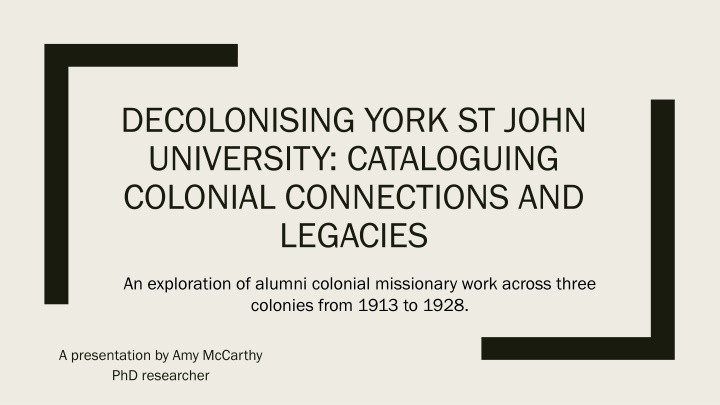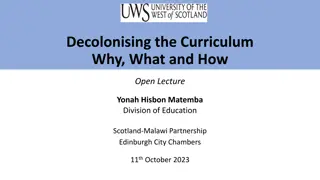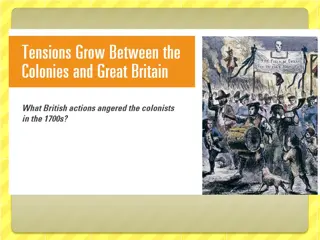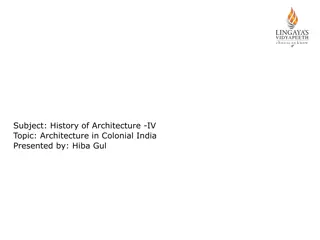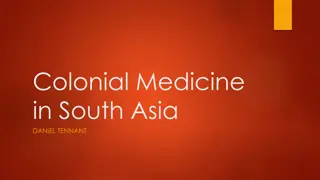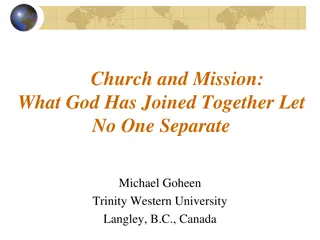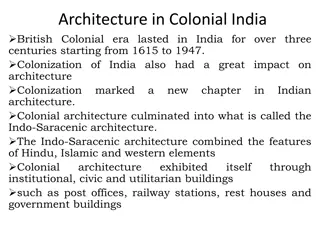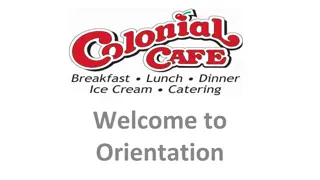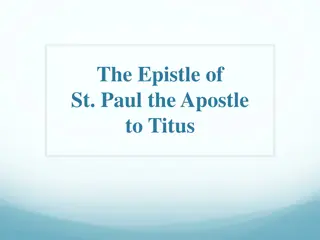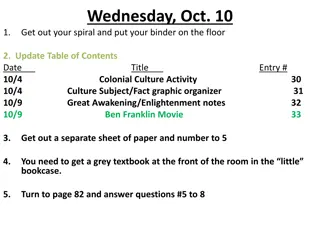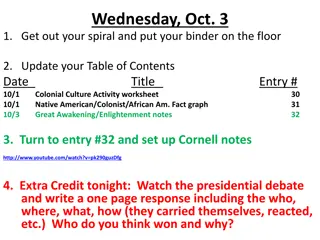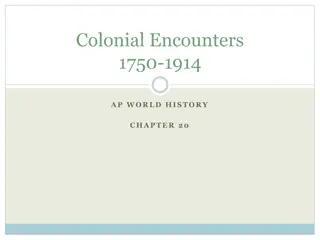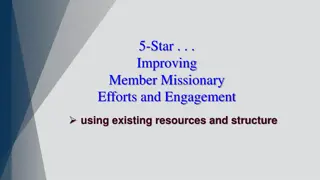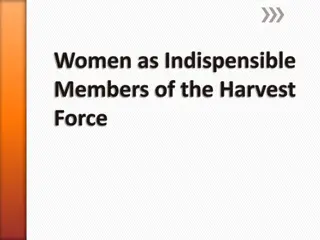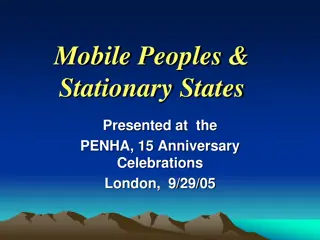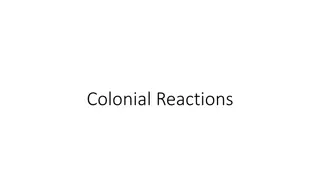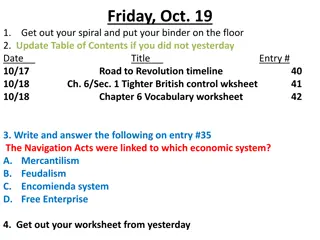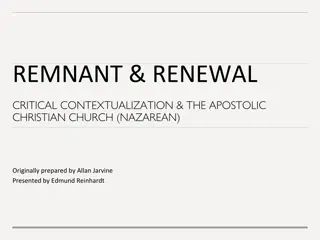Decolonising York St. John University: Colonial Missionary Work Analysis
This presentation delves into alumni colonial missionary work in three colonies from 1913 to 1928, exploring entries in the Ripon College Association Magazine. It examines the impact of evangelical education, missionary efforts, and the legacy of alumni missionaries in different regions around the world.
Download Presentation

Please find below an Image/Link to download the presentation.
The content on the website is provided AS IS for your information and personal use only. It may not be sold, licensed, or shared on other websites without obtaining consent from the author.If you encounter any issues during the download, it is possible that the publisher has removed the file from their server.
You are allowed to download the files provided on this website for personal or commercial use, subject to the condition that they are used lawfully. All files are the property of their respective owners.
The content on the website is provided AS IS for your information and personal use only. It may not be sold, licensed, or shared on other websites without obtaining consent from the author.
E N D
Presentation Transcript
DECOLONISING YORK ST JOHN UNIVERSITY: CATALOGUING COLONIAL CONNECTIONS AND LEGACIES An exploration of alumni colonial missionary work across three colonies from 1913 to 1928. A presentation by Amy McCarthy PhD researcher
Introduction. Supervisors for the project: Dr. Ben Garlick, Dr. Adam Stock, Dr. Alex Beaumont and Thomas Peach. York St John alumni have travelled the world to continue their teaching careers. This presentation will explore entries from the Ripon College Association Magazine from 1913 to 1928. This presentation will focus on specifically on the entries of Miss Ethel Marston in Ontario, Canada, Miss Mary Whitaker in Ranchi, India and Miss Mary Mander in Tokyo, Japan. The entries are best understood as pieces of travel writing and offered imagined and romanticised versions of the areas and communities the missionaries worked in.
Evangelical education and missionary work. Christian evangelism [ ] shaped education and identity both at home in Britain and abroad (Procter, 2020, p.120). It is particularly evident in the area of gender and sexuality that they were neither for nor against the imposition of colonial rule in any uncomplicated manner. Missionaries contradicted some of the more racist views of their colonial counterparts. In order to believe in the feasibility of their evangelical projects they had to maintain a belief in the potential of 'lower' heathen races to learn and 'improve' with Christian tuition (Johnston, 2003, p.54). Missionaries very presence in the colonies disrupted the cultural unity on which white supremacy depended (Thorne, 2006, p.145). In considering the question of definite teaching, there are two main aspects from which it will be helpful to view this wide subject: - (1) The value, and in fact the necessity of such definite Church teaching, and (2) whether there is any way by which we can improve our present practice in Sunday school (Mander, 1906, p.28).
Missionary work in the alumni magazines. Missionaries aimed to raise money and recruit volunteers to support their work abroad when they returned home on furlough (Thorne, 2006, p.153). Furlough allowed missionaries to return home to visit family and friends as well as give talks about the mission work to raise funds and to gain recruits (Allen, 2010, p.87). Mrs Coward and Miss Boyd moved to Japan after Miss Mander s first entry to the magazine. Writing about their experiences in the alumni magazine aimed to encourage readers to do the same, and spread Christian values across the Empire.
Ethel Marston in Ontario, Canada. The League of Empire s Scheme for the Interchange of Teachers with the Colonies allowed a British teacher [to spend] 12 months in a selected Dominion, taking the place of a colonial teacher who, in return, spent the year teaching in the place of the British teacher (Crutchley, 2015, p.730). Professionally little is to be gained from an exchange with a Canadian teacher. Canadian methods seem to be much behind those of our country (Marston, 1924, p.53). Canada is essentially a land of sunshine, sunshine that is reflected in the warm hearted hospitality of its people and their happy lives (Marston, 1924, p.56).
Mary Whitaker in Ranchi, India. The main language is Hindi. Then in schools, all high school education is in English (but there is not a girls high school), our school vernacular is Hindi, [23] there are schools lately started for Bengali speaking children here, and in the country there are Numdari schools. Also the poorer people speak Ganwari, a patois of Hindi, and that has to be used to a certain extent in the lower standards or the children would not understand. (Whitaker, 1914, pp.23-24)
Mary Mander in Tokyo, Japan. They are beginning to think earnestly and with an increasing sense of personal responsibility about all kinds of modern problems: problems arising from the clash of modern ways and thought with the old-fashioned Japanese customs and etiquette of their parents and grandparents; problems about religion, especially Buddhism and its claims on their allegiance as compared with the conflicting claims of Christian teaching; problems of social service, political questions especially the franchise for women, careers for women, and finally the terribly difficult problem of harmonising the modern attitude of mind and action with the customary Japanese relations between parents and child, and more vitally between husband and wife. The students read English easily and are full of longings to copy the English and American women students about whom they read; and if they try to do so and adopt some of the free methods of the West they quickly find themselves up against the prejudices of a dearly loved parent who expects to be obeyed and usually is not disappointed; and after marriage the tyranny of husbands and in laws is usually even more complete than that of the parents. (Mander, 1928, pp.6-7)
Conclusion. Catalogued the entries for the Ripon College Association Magazine and transcribed the entries from missionaries in Canada, India and Japan. The archives are a useful tool and should be further explored. Further investigation and documentation of missionary work from alumni of York St John and Ripon Colleges. Archives to be used as a tool for future student researchers, dissertations and reflections around teaching policy and practice within the institution.
Bibliography Allen, M. (2010) That s the Modern Girl Missionary Women and Modernity in Kolkata, c.1907 c.1940 , Itinerarlo, 34 (3), pp.83-96. angelican.ca. (2021) Timeline , angelican.ca, https://www.anglican.ca/wp-content/uploads/2014/05/timeline.pdf [Accessed 25 June 2021]. Ashcroft, B. and Griffiths, G. and Tiffin, H. (2002) The Empire Writes Back: Theory and practice in post-colonial literatures. London: Routledge. Badcock, Rev. C., (1892) Origin and the Early Days of the Ripon Training College , Ripon College Association Magazine, FBA 1, 1892-1894, pp.11-19. Choudhary, S. K. (2019) The contribution of Christian missionaries to educational development: a study of tribals in Jharkhand , Asian and African Studies, 28 (2), pp.180-204. Crutchley, J. (2015) Teacher mobility and transnational, British World space: the League of the Empire s Interchange of Home and Dominion Teachers , 1907-1931 , History of Education, 44 (6), pp.729-748. Duncan, J. and Ley, D. (1994) Place/Culture/Representation. New York: Routledge. Editor. (1914) Miss Whitaker s Work in India , Ripon College Association Magazine, FBA 25, vol. 6. 1912-1915, pp.42-43. Johnston, A. (2003) Missionary and Empire, 1800-1860. Cambridge: Cambridge University Press. Mander, M. (1906) Definite Church Teaching by Miss Mander Ripon College Association Magazine, FBA 23, vol. 4. 1904-1907, pp.28-30.
Bibliography cont. Mander, M. (1918) Letter from Miss Mander , Ripon College Association Magazine, FBA 26, vol. 7. 1916-1919, pp.19-22. Mander, M. (1924) Earthquakes , Ripon College Association Magazine, FBA 28, vol. 9. 1924-1927, pp.47-49. Mander, M. (1928) College News , Ripon College Association Magazine, FBA 29, vol. 10. 1928-1931, pp.5-9. Marston, E. (1924) A Year in Canada , Ripon College Association Magazine, FBA 28, vol. 9. 1924-1927, pp.50-56. Morrison, H. (2013) Impressions which will never be lost : Missionary Periodicals for Protestant Children in Late-Nineteenth Century Canada and New Zealand , Church History, 82 (2), pp.388-393. Newby, C. (1922) The Teaching of Religion in Day and Sunday Schools , Ripon College Association Magazine, FBA 27, vol.89. 1920-1923, pp.25-27. Procter, A. (2020) The Whole Picture: The colonial story of the art in our museums & why we need to talk about it. London: Cassell. Said, E. (1979) Orientalism. New York: Vintage Books. Thorne, S. (2011) Religion and empire at home in: Hall, C. and Rose, S. eds. At Home with the Empire: Metropolitan Culture and the Imperial World. Cambridge: Cambridge University Press, pp.143-165. Viswanathan, G. (1987) The beginnings of English literary study in British India , Oxford Literary Review, 9 (1-2), pp.2-26. Whitaker, M. (1913) Miss Whitaker s Letter , Ripon College Association Magazine, FBA 25, vol. 6. 1912-1915, pp.23-26. Whitaker, M. (1935) Education in India , Ripon College Association Magazine, FBA 30, vol. 11. 1932-1935, pp.10-13.
